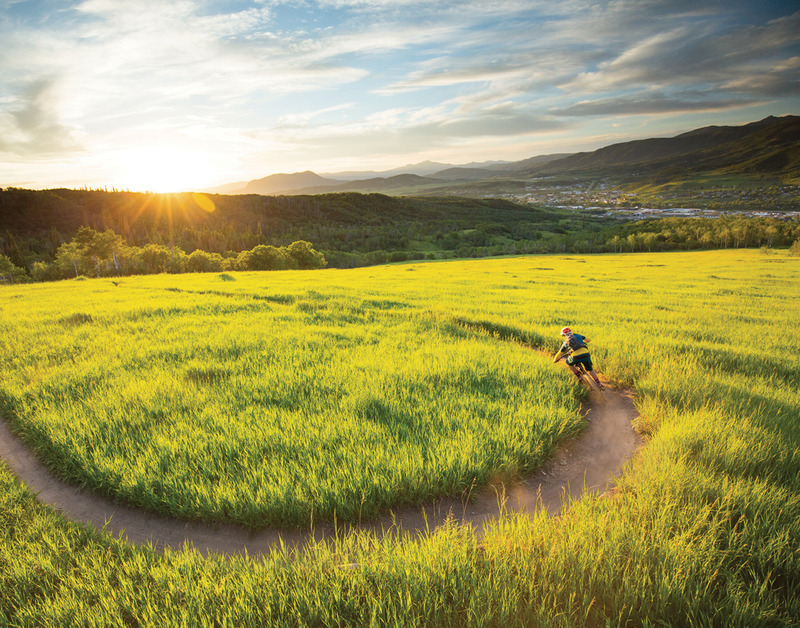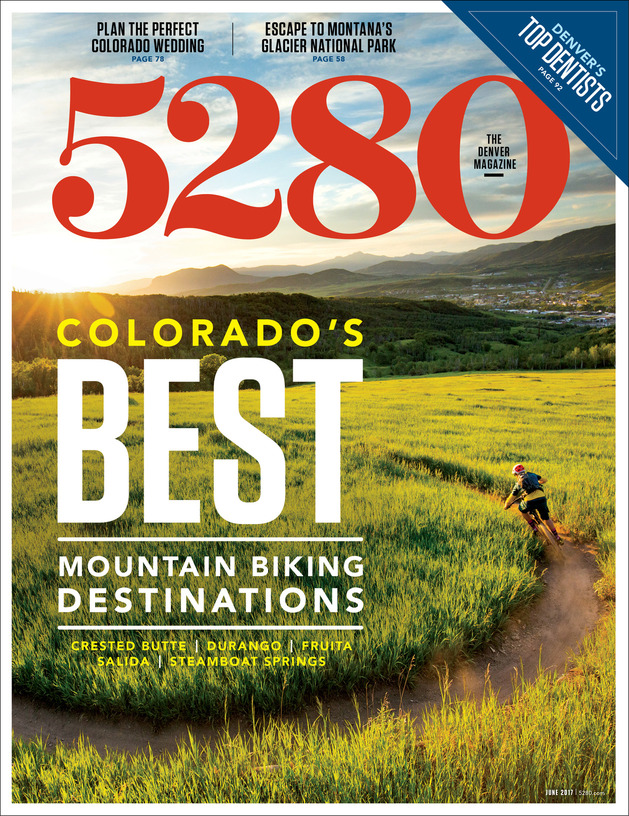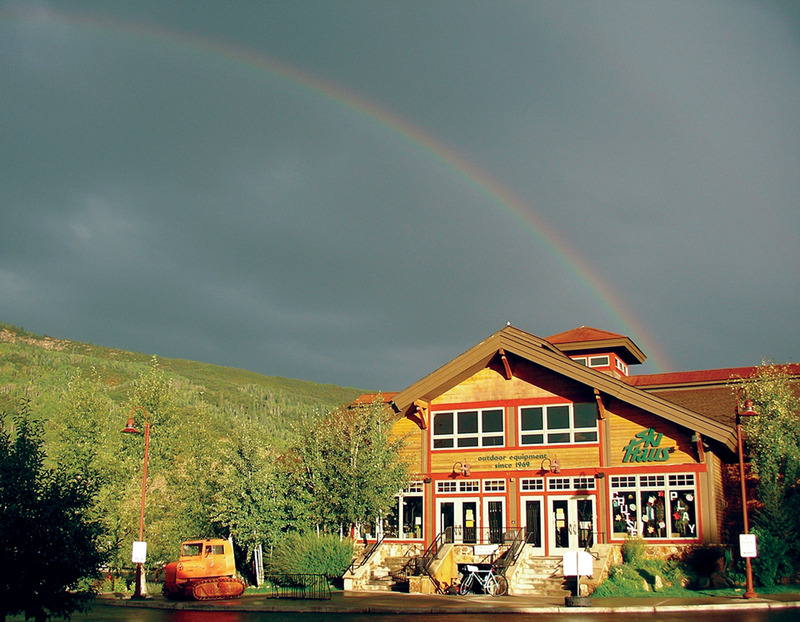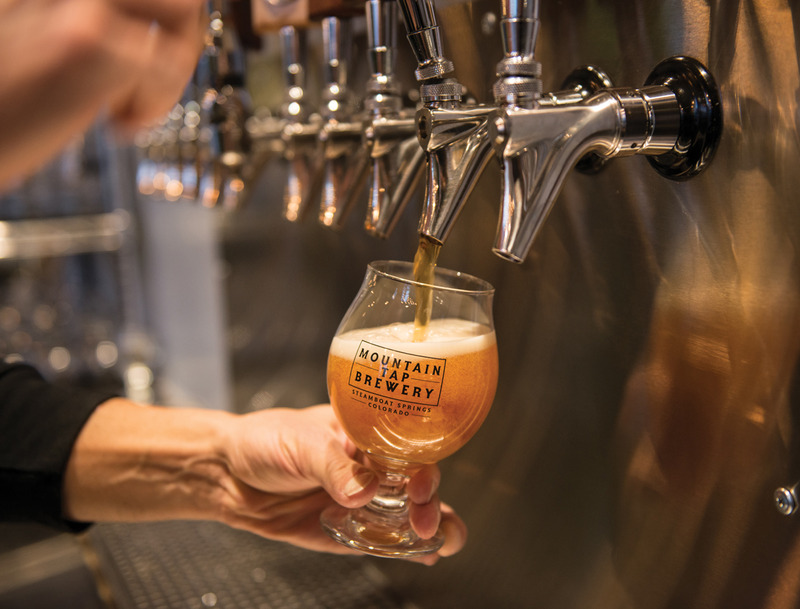The Local newsletter is your free, daily guide to life in Colorado. For locals, by locals.
Steamboat Springs
Virtually everyone rides singletrack (see “Learn The Lingo” below) in Bike Town USA, where the appeal is obvious: Steamboat’s smoother-than-average trails make mountain biking accessible to mortals who prefer to savor ranchland views rather than battle flat-tire-inducing rocks. Yes, there are some technical spots, especially on circuits plumbing the Medicine Bow-Routt National Forest adjacent to town. And the adrenaline-dependent crowd can air it out on Steamboat Bike Park’s more than 50 lift-served miles. But the soul of Steamboat riding is made of gentle dirt ribbons that wind for miles through silvery aspens, lemon yellow mule’s ears, and open ridgelines overlooking the vast hayfields of the Yampa Valley. Consider it all core—the “hard” is optional. —Kelly Bastone

Divide Trail
Total Mileage: About 25
Difficulty: Very difficult
Map: steamboatbiketown.com
Get There: Ask a friend to drop you off at the parking pullouts on CO 311 just past the Dumont Lake campgrounds (off U.S. 40, about 20 miles southeast of town) to avoid having to retrieve your car later.
This 25-miler starts high (at 9,500 feet, atop Rabbit Ears Pass) and stays high, cruising among alpine lakes and meadows for about 15 miles before reaching the top of the ski resort—and ending with an exhilarating 3,668-foot descent to the base area. After saddling up (begin early to be off the peaks before afternoon storms), follow the signed, obvious trail on the west side of CO 311 a short way to where it pops out on Campground Road. Ride this to a slight right on Trail 1101. Follow that for four wildflower-framed miles to Base Camp Road, where you’ll turn left and climb for about a half-mile until you reach the Base Camp trailhead. The next rock-studded mile and a half to Fishhook Lake demands technical bike-handling skills, but then the path loses its bite and presents open meadows and lakes fringed with spruces. At the four-way junction, turn left and ride to Long Lake. Bear left and follow the Mountain View Trail past lakes where moose congregate. Top out at a rocky grandstand that presents views to the Gore Range, and then continue to Mt. Werner. From there, it’s all downhill to the resort’s base and the patio (and pints) at Slopeside Grill.

Morning Gloria Trail
Total Mileage: About 12
Difficulty: Easy
Map: steamboatbiketown.com
Get There: Park at the rodeo grounds and follow the Lower Lupine Trail, which departs from just behind the arena, to the Morning Gloria Trail (go left at the sign).
Located along the western edge of Steamboat Springs’ historic downtown, Emerald Mountain features a 40-or-so-mile network of mostly buffed-out trails that facilitate everything from 30-minute quickies to five-hour adventures. The four-mile-long Morning Gloria Trail offers a meandering, gentle rise to the top of Emerald Mountain. Combine it with the Lupine Trail for a roughly 12-mile medley of aspen forests, ridgeline vistas, and verdant ferns. The descent via Quarry Mountain Trail is a fast and fun route through pine forests and open hillsides.
Diamond Park Trail
Total Mileage: 8 or 10
Difficulty: Easy/More difficult
Map: steamboatbiketown.com
Get There: From downtown Steamboat, drive north on County Road 129 roughly 22 miles to where it intersects with Seedhouse Road. Turn right and stay on Seedhouse Road for just more than eight miles to Seedhouse Campground.
Thanks to wildflower meadows, panoramas of jagged peaks, and its outside-of-town location—it’s perched on the edge of the Zirkel Wilderness—this ride feels remote. But technically and aerobically, it’s actually one of the easiest circuits in Steamboat’s portfolio. From the trailhead near Seedhouse Campground, the singletrack parallels the North Fork of the Elk River on a former roadbed, so climbs along this rolling route are short and forgiving. Just over four miles in, at Diamond Park—where wildfire-thinned trees allow for sweeping views of the Zirkels—you can cross the bridge and turn right to create a loop (10 miles) via Trail 1101. Note: Frequent rock and root features make this the blue option. Or return the way you came (eight total miles) to enjoy the same scenery in reverse.
What To Know If You Go To Steamboat Springs:
Stay: Located eight miles from Steamboat in the Medicine Bow-Routt National Forest, Dry Lake Campground’s eight sites ($10, no reservations) put cyclists adjacent to the Spring Creek Trail, a breezy five-miler into town. Meanwhile, Sheraton Steamboat Resort (from $179) provides easy access to Steamboat Bike Park. 970-870-2220
Eat: Find burgers done right (fat, juicy, and grill-marked) at Back Door Grill and beer done even better at Mountain Tap Brewery.
Shop: Demo a bike or get yours trip-ready at Ski Haus.

Fruita
Who needs Moab when you’ve got Fruita? Ninety minutes closer to Denver than Utah’s fat-tire hub and tucked against the Colorado River and Colorado National Monument, Fruita’s Kokopelli trail system boasts the same sought-after red rock features—with a lot less highway time. Plus, once you’ve had enough of the technical challenges on the south side of I-70, you can head to the nearby 18 Road area for something entirely different: undulating trails with big, roller-coaster drops next to the Book Cliffs’ sandstone buttes. —Chris Outcalt
Holy Cross
Total Mileage: About 6
Difficulty: Very difficult
Map: copmoba.org
Get There: From Fruita, take I-70 east to Exit 26 and stay right to take U.S. 50 toward Grand Junction. Look for a right onto 25 Road, which turns into Riverside Parkway. Turn right onto West Avenue, right on Broadway, and then left on Monument Road, which winds 1.5 miles to the Tabeguache trailhead.
When you’ve had your fill of Fruita’s classic sandstone, the Lunch Loop in Grand Junction is an excellent option for experienced riders looking for something rocky and technical. Test your fitness and maneuvering ability on the Holy Cross Trail, a demanding 2.7-mile plunge in the middle of the Lunch Loop system. To access Holy Cross, pedal about two miles on the masochistic Tabeguache Trail until you reach the signed intersection with Holy Cross Trail on your left. After nearly three miles of death-gripping down this rocky obstacle course, your arms will feel like you’ve spent too long on a pogo stick. Fortunately, the rest of the way down—via Ali Alley to Raven Ridge and then Curt’s Lane and Curt’s Down—is slightly less demanding.

Mary’s Loop to Horsethief Bench Loop
Total Mileage: About 12 to 14
Difficulty: More difficult
Map: copmoba.org
Get There: To get to the main trailhead parking lot, take Exit 15 off I-70, cross back over the interstate, and follow signs to the Kokopelli trailhead. (There’s also a tiny parking area about a mile up the road right next to the trailhead, but spots fill quickly.)
No ride embodies the essence of Fruita more than the Mary’s Loop and Horsethief Bench Loop combination. Mary’s Loop begins with a short but draining climb up washed-out, rocky doubletrack. So you’ll be happy when you get to the intersection for Horsethief and its famous “hike-a-bike” entrance after about a mile and a half. (Mary’s Loop continues, but don’t worry, you’ll come back for the rest.) Here, you’ll hop off your ride to navigate the massive rock drops down to the trailhead—unless you’ve recently competed in the X Games, in which case, stay seated and show the crowd how it’s done. Then the real fun starts: The nearly four-mile, clockwise Horsethief loop is twisty and fast and affords wide-open views of the Colorado River and Black Ridge Canyons Wilderness Area. There’s a large slickrock drop around one of the trail’s first big bends that some might want to walk, but confident intermediate riders should be able to handle it. When the trail starts to wind away from the river after about a mile and a half, be on the lookout for a stretch of tricky rock ledges. After that, it’s mostly smooth riding on dirt singletrack and a slow, steady rise for a little over a mile back to the hike-a-bike section, where you can pick up where you left off on Mary’s. The next 3.5 up-and-down miles are relatively easy; although the trail is rocky, there’s nothing overly technical that’ll force you off your mount. Complete the loop by taking the dirt road 2.3 miles back to the main parking lot, or opt for the 4.5-mile Moore Fun Trail, a highly technical double black diamond where big rock obstacles and ledges abound.
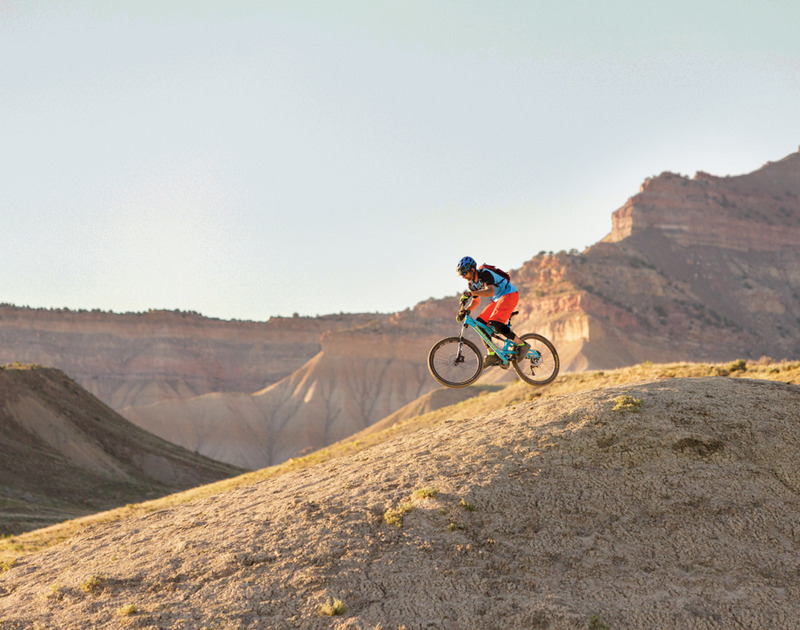
Prime Cut to Joe’s Ridge to Kessel Run
Total Mileage: About 5
Difficulty: More difficult
Map: copmoba.org
Get There: Take Maple Street north from downtown for 3.5 miles and turn right on N 3⁄10 Road and then left on 18 Road. Follow 18 Road north for another seven or so miles until you hit the parking lot. All of the 18 Road trails are accessible from here.
Nestled up against the Book Cliffs in the 18 Road area, this route keeps the uphill challenge to a minimum while maximizing the amount of thrilling downhill. Look for the Prime Cut Trail on the east side of the parking lot and begin the gradual climb; you’ll gain about 400 feet of elevation over the next two miles. At the end of Prime Cut, take a left onto Frontside Trail, crossing over 18 Road and passing by a parking area until you reach the sign for Joe’s Ridge, a good intro to the big, white-knuckle drops on many of the 18 Road trails. After about a mile you’ll come to a large intersection; turn left and then right to connect to Kessel Run’s singletrack, where you’ll spend the next mile or so swooping around a series of fast bank turns.
What To Know If You Go To Fruita:
Stay: Reserve a campsite with bathroom facilities and fire pits along the Colorado River at James M. Robb – Colorado River State Park, about a mile from the heart of Fruita. From $18
Eat: Start the day with a pour-over from Bestslope Coffee Company; end it with the Broken Oar IPA at Kannah Creek Brewing Company.
Shop: With quick-tune options and a knowledgeable staff, Over The Edge Sports bike shop has been a Fruita staple for decades.

Crested Butte
With more than 700 miles of trail, the country’s oldest mountain biking club, and some of the best wildflower viewing in Colorado, it’s little wonder Crested Butte is regularly hailed as one of the top mountain biking destinations in America. Savor its colorful scene from the saddle on blown-open high-alpine treks as well as on twisty trails through tight trees. And since the Butte’s famous wildflower season now extends deeper into August (thanks, climate change), you can—and should—sneak in a second trip to this West Elk Range fat-tire mecca before the summer’s over. —CO
Teocalli Ridge
Total Mileage: About 11.5
Difficulty: Very difficult
Map: crestedbuttemountainbike.com
Get There: From town, drive south on CO 135 and take a left on County Road 738; follow it about four miles until it meets West Brush Creek Road. The trail starts here, but park in the pull-off on the right past the intersection.
Every fat-tire fiend who shows up in Crested Butte looking for an #epicride heads for the 401 Trail at the top of 11,000-foot Schofield Pass. Let them. You, meanwhile, should ride the no-less-epic-but-a-lot-less-crowded Teocalli Ridge Trail. The initial long, sustained ride up doubletrack West Brush Creek Road gets prettier as you pedal, with lush Teocalli Mountain playing peekaboo while you wind through aspens. (Be aware: There’s a stream crossing about a mile up that can be prohibitive early in the season due to runoff.) After about three miles, the road ends and the truly grueling climb up the skinny Teocalli Mountain Trail begins. Unless you’ve got legs of steel, you’ll be walking a few sections on an exposed ridge, but the sweat fest finally ends after about five miles at 11,200 feet. Your reward? Views of the West Elks and lunch on a rocky outcropping. The 4.5-mile-long grade back down is precipitous and rooted at first, but after a mile or so it transitions into a rousing, obstacle-free stretch in dense trees. Teocalli finishes back at your car after a lightning-quick section that rolls through an open meadow flecked with wildflowers.

Strand Hill
Total Mileage: About 4
Difficulty: More difficult
Map: crestedbuttemountainbike.com
Get There: From town, drive south on CO 135 and then take a left on County Road 738 (Brush Creek Road); follow it for 2.5 miles to the Brush Creek trailhead and park in the lot on your left.
Despite Strand Hill’s somewhat unremarkable ascent, the three-mile plunge, through aspens and open meadows, easily qualifies this CB classic as one of the top rides in a town that’s full of immaculate singletrack. Begin with a switchbacking climb up Farris Creek Road, a wide trail that’s steep, but never too steep. (Note: There are a few cattle guards on this loop; close the gates after passing through them.) After about 1.5 miles, you’ll top out at a wood sign marking the beginning of the Strand Hill descent. Pause to rest your legs and catch your breath—you’re about to ride some of the most pleasing, flowy downhill in town. Although the trail—which winds through a series of dense aspen groves—cascades mostly downward from here, there are some short inclines that require a more forgiving gear. The trail is a good choice for confident beginners looking to push themselves: For the most part, Strand offers a smooth ride, but there are a few technical spots with gnarled roots and tight trees, and occasionally the trail narrows to the width of a tire. When things flatten out, turn left at the Canal Trail and end with a welcome spray from a small stream crossing.

Lupine 1 and 2 to Lower Loop
Total Mileage: About 10
Difficulty: Easy
Map: crestedbuttemountainbike.com
Get There: Ride your bike from the northwest corner of town along the Rec Path to the Lupine Trail at the end of Saddle Ridge Road (there is no parking there).
If you’re a beginning mountain biker, opt for the Lupine–Lower Loop combo. After a short ascent, the trail begins to dip and bank through thickets of—you guessed it—lupines, a flowering plant that paints the landscape purple, pink, yellow, and red. You won’t run into any technical features on the trail, but you might run into cattle; we got stuck behind a mom and its calf on a tight trail for half a mile. After finishing the 3.5-mile Lupine Trail, cross Slate River Road and ride west for a half-mile until you see signs for Lower Loop, an easy, straightforward stretch back to town for a slice and a pint at the Secret Stash pizzeria.
What To Know If You Go To Crested Butte:
Stay: There’s plenty of first-come, first-served camping along Gothic Road above Mt. Crested Butte. (Note: Dispersed camping is not allowed between June 15 and August 15, but you are allowed to camp at one of the four established first-come, first-served sites at Gothic Campground.) If you can’t snag a spot, The Grand Lodge Crested Butte is a good, pet-friendly option. From $112
Eat: Grab a stool at Elk Ave. Prime’s community table and ask for the bar menu, which is more modestly priced but just as tasty.
Shop: Big Al’s Bicycle Heaven at the end of Elk Avenue earns high marks from locals for its tunes.
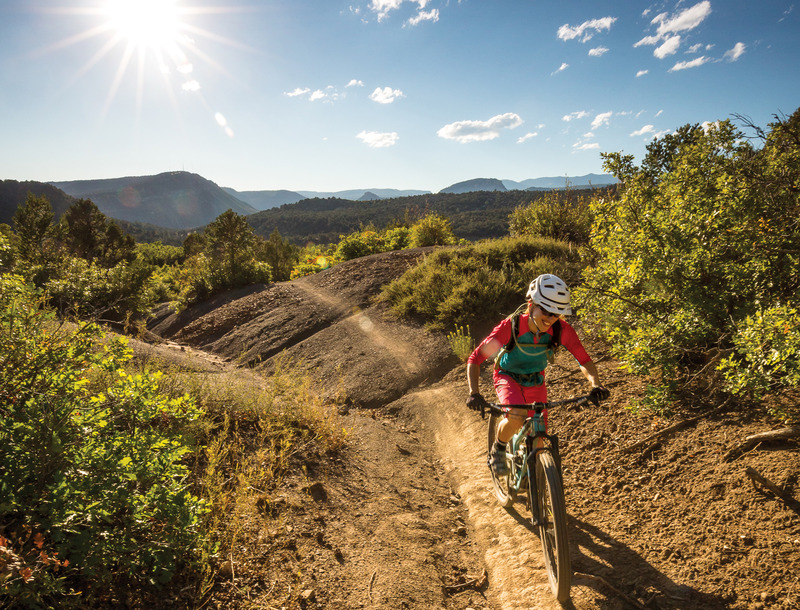
Durango
Sandwiched between the rugged San Juan Mountains and the Seussian rock formations of the Four Corners area, Durango provides a tremendous array of options for everyone from rookie rippers to freakishly strong single-speed riders. More than 300 miles of trail—velvety, rolling jaunts and all-day high-country rides up rocky passes—sit within 30 minutes of town. Perhaps Durango’s most appealing quality, though, is just how generous the community is with its trails: Many of them have been lovingly built, marked, and maintained by Durango nonprofit Trails 2000, and locals love to share them with visitors. —Katie Klingsporn
Telegraph to Sidewinder Loop
Total Mileage: About 9
Difficulty: Very difficult
Map: trails2000.org
Get There: You’ll find the start of Horse Gulch Road at the eastern end of East Third Street downtown.
Horse Gulch, a 1,296-acre tract of land managed by the town, has a trail for everyone: swooping descents, middle-of-a-meadow meanders, rocky gullies, and a super technical line that scales prominent Raider Ridge. Excellent signage makes it easy for even first-timers to navigate. Sample the best of Horse Gulch with the Telegraph to Sidewinder route. From East Third Street, climb the wide Horse Gulch Road about three-quarters of a mile until you see a large map where the track flattens out and a meadow opens up. From there, take the prominent singletrack to your right to connect to Telegraph Trail. This 1.75-mile section ascends through scrub brush before zigzagging up the flank of Pautsky Point and ending with a steep, quad-burning finale that lasts a half-mile. Reset your heart rate at the top while enjoying views of Durango’s high-desert hill country, then continue down the trail, taking your first right to connect to Sidewinder. After about 1.5 miles, you’ll reach the intersection for Crites Connect. Go right and pedal 1.5 miles back to the top of Telegraph, where you can take a left to reach Anasazi Descent, a sharp and technical (but short) downhill that deposits you at the Meadow Loop. Go right here to finish with a breezy one-mile circle, staying left on the trail until you return to the map and zoom back to the trailhead.

Twin Buttes
Total Mileage: 7.5 miles from the trailhead; 9.5 miles from downtown
Difficulty: More difficult
Map: trails2000.org
Get there: Most routes begin at the main trailhead in a dirt parking lot on U.S. 160, just north of the Giant gas station.
Snuggled up against the Perins Peak area, 675-acre Twin Buttes features tight switchbacks, strenuous ascents, fast descents through gambol oak and pine, and get-off-your-bike-and-snap-a-selfie views of the Animas River Valley. For a lively loop with plenty of elevation gain, start with the Twin Buttes Trail, a 1.7-mile grind through ponderosa stands. At the top, veer left onto the Lower Loop Trail and follow it about a quarter-mile to Upper Twin Buttes Trail, where you’ll pedal through pines for another mile before arriving at an intersection. A right takes you through a series of mettle-testing switchbacks that leads to high meadows and valley views, including a vista of the backside of Durango’s iconic Hogsback formation. From here you get an easy drop to the junction with Upper Ed & Flow; go right for a swift and exciting 1.3-mile ride to the linkup with Ed & Flow. A final swoopy three-quarter mile section delivers you to Lightner Creek Trail, which will take you back to the trailhead, or hop on U.S. 160 for the roughly two-mile ride back to town.
Overend Mountain Park
Total Mileage: 4
Difficulty: Easy / More difficult
Map: trails2000.org
Get There: Start at the Crestview trailhead at the end of Leyden Street, on the west side of the Animas River.
The Overend Mountain Park, named for biking legend Ned Overend and locally known as Test Tracks, is a 300-acre patch of scrub oak latticed with buttery trails, crazy switchbacks, and well-placed berms. For a fun sampler, start at the Leyden Street trailhead, where you can hop on the Crestview Trail for a half-mile warmup around town. Connect with Hidden Valley Trail, which threads through shadowy forests as it climbs one mile toward Graben’s Loop. Take a left here for another half-mile ascent on Graben’s until you reach Star Wars, an exhilarating quarter-mile downhill that evokes the speeder bike chase in Return of the Jedi. At the bottom, take a left to return to town via the Perins Gulch Trail.

What To Know If You Go To Durango:
Stay: Find a campsite at Junction Creek Campground ($22), located six miles northwest of Durango. If you want a bed and a hot shower, check into the historic Leland House & Rochester Hotel downtown (from $259).
Eat: For post-ride calories, grab a made-to-order burger, hand-cut fries, and a cold beer at Grassburger on Main Avenue.
Shop: Durango Cyclery, the town’s longest-running, employee-owned shop also sells recycled bikes

Salida
Don’t let Salida’s reputation as a white-water mecca fool you: This Arkansas River Valley town is as much a paradise for pedalers as it is for paddlers. Mountain bikers typically come for the must-ride Monarch Crest Trail and stay to explore the area’s more than 500 miles of bikeable trail, like Salida’s iconic S-Mountain, which holds convenient options that begin wherever your car is parked. And unlike many of Colorado’s other fat-tire-friendly towns, Salida gets enough sun and warm days to make many of the trails ridable most of the year. (Take that, river rats.) —CO
Monarch Crest Trail
Total Mileage: About 34
Difficulty: Very difficult
Map: salidamountaintrails.org
Get There: This ride, which requires a shuttle, starts past Monarch Ski Area at the Monarch Pass trailhead on the east side of the road.
When it comes to high-alpine riding, it doesn’t get much better than the Monarch Crest Trail west of Salida. For starters, the majority of the ride sits above treeline. Translation: Be ready to revel in some of the most jaw-dropping views of the Collegiate Peaks you can get from the saddle. You’ll want to peel your eyes away from the vistas to negotiate a few steep, rocky sections, but most of the trail won’t test your technical skills. That’s not to say it’s easy. From the Monarch Pass trailhead, you’ll pump up a short stretch of doubletrack road. You’ll have to grind skyward for about 4.5 miles before the descent begins—and once it starts, it doesn’t quit. You’ll drop more than 4,000 feet over the next 30 miles. After about 9.5 miles, look for the well-signed Silver Creek Trail on your left; take it 4.5 miles on rocky but ridable singletrack before connecting with the Rainbow Trail. Rainbow has some rooted and boulder-filled segments and a few modest uphills, but you get a reprieve after 10 miles when you hit a paved road. Five miles of blacktop riding delivers you to Poncha Springs. Arrange for a pickup there, or if you’re staying in Salida, ride another five miles to town.

Frontside to North Backbone to Cottonwood
Total Mileage: About 21
Difficulty: Very difficult
Map: salidamountaintrails.org
Get There: Take F Street from downtown across the river to a parking lot, then look for the Frontside trailhead to your right at the base of Tenderfoot Mountain.
From about anywhere in downtown Salida, if you look east, on the far side of the Arkansas River you’ll see a hill with a giant S inscribed on its face. That’s Tenderfoot Mountain, colloquially called S-Mountain and home to the Arkansas Hills Trail System. Pedal the switchbacking, mostly smooth Frontside Trail up, well, the front side of the mountain (1.1 miles). From here, you’ve got plenty of choices. For a big black diamond loop, start by taking the mellow Lil’ Rattler a mile to North Backbone (all S-Mountain trails are well marked). After 3.2 miles of up-and-down technical riding, hang a right on County Road 175 and pedal uphill on a mountain road for about five miles to a small parking area on the right. From here, you’ll begin a 7.5-mile decline on the Cottonwood Trail. The first third is relatively smooth, but the path becomes increasingly technical the farther you go. Look for the Backbone Trail on your right and ride that rolling path 1.6 miles back to Lil’ Rattler. Descend Lil’ Rattler and Frontside back to town and a post-ride beer at one of the many patios along the river.
Little Rainbow Trail
Total Mileage: 13
Difficulty: Easy
Map: salidamountaintrails.org
Get There: Ride County Road 110 south from downtown for about four miles to the Little Rainbow trailhead on your left.
An ideal beginner trail, Little Rainbow starts just outside of downtown Salida. From the parking lot, you’ll get about five miles of fast, easy hills through piñon trees punctuated by views back down the valley to Salida. At the end of Little Rainbow, follow signs to Race Track for a tight 1.5-mile descent that’ll have you hollerin’ with glee. Race Track connects with U.S. 50, where you’ll turn left and ride about two miles on the road back into town. If you’re looking for a serious workout, this route can also be ridden in reverse.
What To Know If You Go To Salida:
Stay: The budget- and pet-friendly Woodland Motel is just a short walk from F Street, downtown’s main drag. From $46
Eat: Lunch or dinner at the Fritz means tasty small plates (try the truffle fries and Brussels sprouts) and a well-curated draft list. 719-539-0364
Shop: Try Absolute Bikes for everything from rentals to ride recommendations.
Go On A Guided Ride
Leave the hard work to the pros while you focus on staying upright.
For Multiday Trips
From lodging at places such as the vista-rich Sand Hollow Resort near St. George, Utah, to your breakfast, lunch, snacks, and dinner, Chasing Epic Mountain Bike Adventures provides everything—including a bike. Book one of Chasing Epic’s eight trips (from $1,250 per person for four days) to places like Fruita, Utah’s Moab, or Taos, New Mexico, and you can choose from the outfitter’s fleet of new Ibis and BMC bikes. Chasing Epic will even throw in a $50 gift certificate to Worldwide Cyclery so you can pick up that last-minute accessory (like, say, an Evoc hydration pack?) you need before hitting the trail.
For Close-To-Home Adventures
If you’re simply looking for a daytrip, Front Range Ride Guides can help. This six-year-old outfitter leads road and mountain rides on the Front Range year-round (in the winter, you can even take a fat bike trip). Custom half-day tours start at $129 per person and include your bike, helmet (and other gear), snacks, and—most important—craft beer at the end of the ride.
For Upping Your Game
Mountain biking isn’t as simple as stomping on the pedals and hoping for the best. To graduate from greens to blues, sign up for one of REI’s local clinics. These five-hour classes go over everything from basics such as trail etiquette to more advanced techniques like dismounting a moving bike. To move on to blacks (and beyond), consider attending a skills clinic with renowned mountain biking coach Lee McCormack. The Boulder-based singletrack guru—who was a member of the 2004 U.S. downhill team at the UCI Mountain Bike Masters World Championships—offers public clinics (from $75) and private lessons and will also travel to coach. —KC
Stuff We Love
Must-have gear from local companies.
MTB Project app, free
This Boulder-based online trail guide and mountain biking app launched in 2013 and today boasts more than 16,000 trails throughout the country. Every trail is reviewed by at least two team members to ensure it’s legal, clear, and mapped correctly, so none of the millions of people who use the site annually waste their precious leisure time.
Hero Kit for Mountain Biking, $45
It’s one thing to get a flat when you’re cruising the Cherry Creek Trail. It’s entirely another when you’re 10 miles into the gnarl on Telluride’s Wasatch Trail. That’s why Hero Kit’s mountain biking option comes with tire patch materials—and just about anything else you might need to MacGyver your way back to the trailhead.
Shredly MTB Short, $95
There’s a reason this Carbondale apparel company has a cult following: Its line of made-in-the-USA women’s clothing combines the technical elements riders need for a day in the saddle with bright designs that stand out on the
trail and around town.

Learn the Lingo
A few key terms for those looking to speak fluent mountain biker.
Bail v. to jump off a bike milliseconds before crashing
Bonk v. to enter a state of complete physical—and mental—exhaustion as a result of not consuming enough calories
Buffed-OUT adj. super smooth; free of ridges, bumps, and obstacles—usually used to describe a trail
Baby heads n. rocks the size of, uh, baby heads, often partially stuck in the ground
Doubletrack n. a wide trail, large enough for two riders to pass without having to yield to each other
Endo n. a crash in which a rider flies, end over end, over the handlebars
Flowy adj. balanced, with fast ups and downs that require little pedaling
Granny gear n. the lowest gear on a bike, typically used for challenging climbs—when you’re going really slowly, like Grandma
Roost n. the dirt or dust that flies up behind a rider who’s going around a corner quickly (as in, a rooster tail)
Singletrack n. a narrow mountain biking trail with room for only one bike at a time
Taco v. to crash in such a way that a wheel becomes folded into a U shape
Wash out v. to lose traction with your front wheel



